The chest-and-back superset session is one of your best training options. It’s grueling and challenging but will leave your upper body with a vicious pump and ensure you hit all critical upper-body muscles.
Arnold often worked his back and chest together in the same workout, switching between exercises for each. He also did this for opposing body parts, like the biceps and triceps.
Antagonist training ensures you do enough work for both sides of the body for better muscular balance.
If you decide to train your back and chest together, you should balance the sets and difficulty for each muscle group through a superset. This will help you build muscular balance.
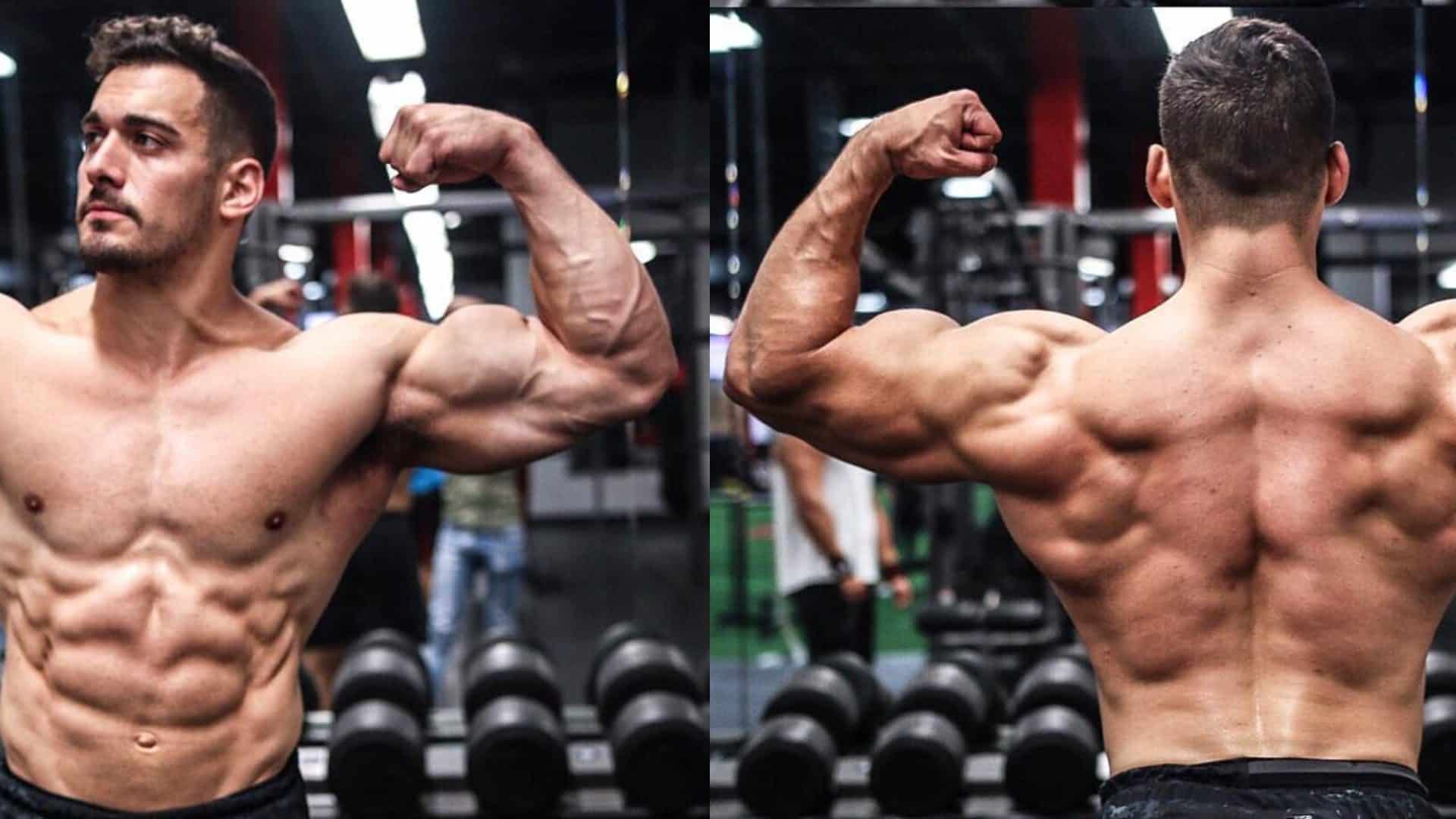
- 12 Best and Chest Exercises for Building Muscle
- 1. Push-Ups
- 2. Bench Press
- 3. Decline Bench Press
- 4. Incline Bench Press
- 5. Seated Machine Fly
- 6. Cable Crossover
- 7. Pull-Up
- 8. Lat Pulldown
- 9. Bent Over Barbell Rows
- 10. Seated Cable Rows
- 11. T Bar Rows
- 12. Deadlift
- How To Design Chest Back Workout
- 1. Weekly Sets For Each Muscle Group
- 2. Select Reps Based On Your Goal
- 3. Design Your Chest Back Workout Routine Split
- 4. Customize Based On Your Schedule
- 5. Beginner-Friendly Chest Back Workout Routine
- 6. Back And Chest Workout Routine For Intermediate
- Advanced back and chest workout routine
- Chest Back Superset Workout Plan
- FAQs
- Can you train back and chest together?
- How Many Sets and Reps Should I Do?
- Back and Chest and superset workout
- How Often You Are Able To Train
- Should I train chest first or back first
- Why You Should Train Back and Chest together on same day workout session
- Takeaways
- References
12 Best and Chest Exercises for Building Muscle
So, here’s a list of a few of the best back and chest workouts for building a strong and healthy body and muscles.
1. Push-Ups
Push-Ups are a popular bodyweight exercise that works for multiple muscle groups, making it a good workout for strengthening the upper body.
While push-ups primarily target the chest muscles, they also engage several other muscles, including the shoulders, triceps, and core.
There are many ways to do push-ups, including different foot positions and body angles. The most common ones are:
- Standard Push Ups: It helps you build your chest, shoulders, and tricep muscles.
- Incline Push Ups: Because of the angle, the Incline push up works your lower chest and core more.
- Decline Push Ups: On the other hand, it works the upper chest and front shoulders (delts) more than the regular or incline variation.
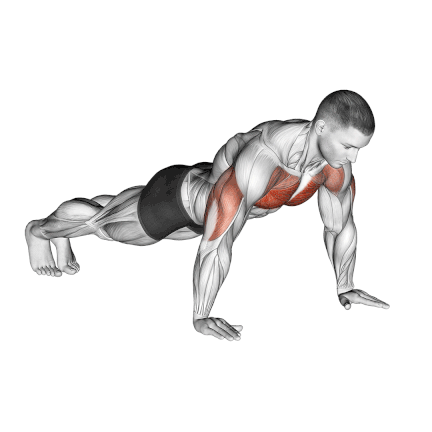
How To Do It Properly
- Lay face down on the ground with your legs straight, and arms supporting your upper body. Keep your knees off the ground.
- Lift yourself off the ground, straightening your elbows and arms. Your elbows should remain close to your body.
- Raise your arms until your elbows are fully, almost locked, and pause at the top of the movement for a moment.
- Now, slowly lower your body until your chest is close to the ground.
2. Bench Press
The bench press is a true powerhouse for building upper body strength and muscle. The bench press primarily targets your chest muscles and also engages your tricep and anterior delt.
If you don’t have access to a specialized bench press rack, a standard flat bench can be used. You can also do bench presses with dumbbells or a barbell.
Depending on your goals, there are different variations of bench presses that work slightly different muscles, too.
- Dumbbell Bench Press: Increased range of motion, greater muscle activation due to independent movement of each arm
- Cable Bench Press: Constant tension throughout the movement, less stress on joints
- Incline Dumbbell/Barbell Press: Shifts focus to the upper chest.
- Decline Dumbbell/Barbell Press: Emphasizes the lower chest.
- Close-Grip Bench Press: Greater triceps activation.
- Single-Arm Dumbbell Press: Challenges core stability and allows for greater focus on each side individually.
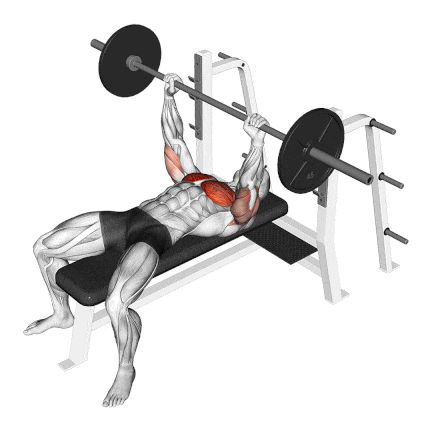
How To Do It Properly
- Lie on the bench with your feet flat on the floor, shoulders back and down.
- Grip the barbell with your hands slightly wider than shoulder-width apart.
- Keep your wrists straight and your elbows tucked at a 45-degree angle.
- Now lower the bar under controlled motion until it is near the chest (around the nipple area).
- Now, raise it until your arms are nearly locked out.
- Keep a controlled motion and avoid jerky movements.
3. Decline Bench Press
The decline bench press is an effective flat bench alternative that changes the angle and tension placed on the chest, increasing the likelihood of new stimulus to the working muscle and, therefore, the b probability of muscle growth in size and strength.
The decline press exercise is much better than the flat bench press for building your lower chest muscles, which gives your chest a fuller, denser, more attractive look.
To do the decline bench press, you’ll need a specialized decline bench that puts the back pad at about a 15-30 degree angle.
Here are a few variations to keep your decline press workouts challenging and effective:
- Barbell Decline Press: The classic. It’s great for heavy loads and building overall strength.
- Dumbbell Decline Press: This exercise allows for a greater range of motion and more independent movement of each arm. (It also fixes muscle imbalances.)
- Machine Decline Press: Offers a guided motion path and is a good option for beginners or those needing extra support.
- Decline Smith Machine Press: increasing stability and allowing the lifting of heavier weights.
- Cable Decline Press: Adds constant tension throughout the movement.
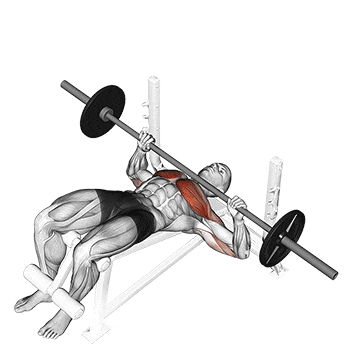
How To Do It Properly
- Place your legs at the end of the decline bench.
- Lift the bar from the rack using a shoulder-width overhand grip on the bar. Hold it over yourself with your arms locked.
- Bring the bar down slowly until you feel the bar on your chest. Pause slightly at this point.
- Move the bar back up to the starting position as you exhale. Use your chest muscles to push the bar. Hold for a second and then bring the bar down slowly again.
Read more to know: How To Do Decline Dumbbell Bench Press With Perfect Technique
4. Incline Bench Press
If you want to build greater thickness and strength in your upper pecs, then you should add incline dumbbell bench press to your training regime.
The incline dumbbell bench press aka dumbbell incline Chest press is an upper body workout that engages the upper pec muscles, the triceps, and the anterior deltoid muscles of the shoulders.
Research shows that the best way to work on the upper part of your chest is to do the incline bench press at a 30-degree angle.
The variations of the Incline Bench Press for achieving a superior upper chest.
- Incline Dumbbell Bench Press
- Incline Cable Bench Press
- Incline Barbell Press with Close Grip
- Single-Arm Incline Dumbbell Press
- Incline Smith Machine Press
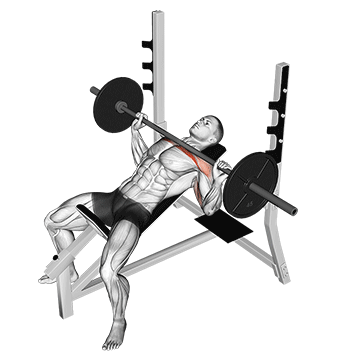
How To Do It Properly
- Lie back on an incline bench. The bench should be adjusted to between 30 and 45 degrees on the incline.
- Lift the bar from the rack with a shoulder-width overhand grip.
- Hold it above your chest with your arms nearly locked.
- Slowly bring the bar down until you feel it touching your chest. Allow a slight pause at this point.
- Raise your arms until they are nearly locked out. Do not bounce the bar off of the chest.
For more information: How To Do Incline Dumbbell Bench Press With Perfect Technique.
5. Seated Machine Fly
The machine chest fly is a strength training exercise that works the chest muscles. It is a popular exercise in gyms and fitness centers because it isolates the chest muscles. This means that the exercise only works the chest muscles without actively working the triceps or shoulders.
There are many different types of flying machine variations that you can try out, which require different types of machine flying equipment or may even require dumbbells.
You could also try doing the fly with dumbbells.
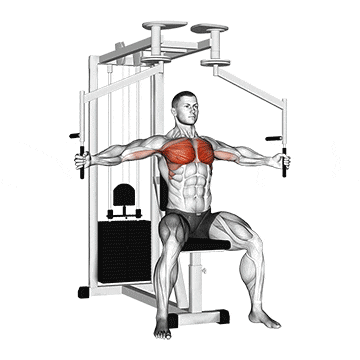
How To Do It Properly
- Ensure you’re sitting up straight and your back is firmly pressed against the padding.
- Hold the vertical handles with your elbows slightly bent.
- Your upper arms should be parallel to the floor.
- Squeeze the handles together until they touch in front of your chest.
- Let your hands move back to the starting position, keeping your elbows up.
6. Cable Crossover
Cable Fly, aka Cable Crossover fly, helps to build massive Pectorals. Crossover provides constant tension in helping build massive pecs.
It also helps to develop and define the Inner and lower chest muscles. Cable provides constant resistance and helps develop the lower and the central chest muscles by providing the much-needed stress in the lower and the inner pecs.
For other excellent variations of cable chest exercises:
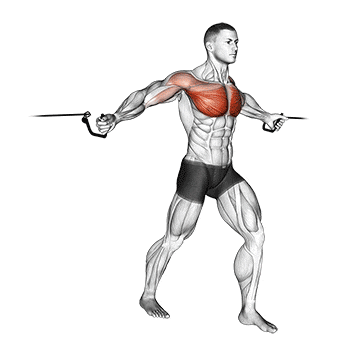
How To Do It Properly
- In a standing position, grab and hold the handles of the overhead pulleys on both sides.
- Bend your arms forward to feel a good stretch in your chest muscles.
- Now flex your arms with elbows slightly bent and get a good chest contraction.
- Unlike chest flies, you can crossover your arms to get a full chest contraction.
Know More: 14 Best Cable Chest Exercises And Workout Routine
7. Pull-Up
The pull-up is an upper-body strength movement that targets the back, shoulders, and arms. It is often a challenge for beginners and even experienced athletes. This bodyweight exercise can induce serious muscle growth in the back and biceps.
The pull-up is harder to perform than a standard pull-up because your hands will be further away from the center of your body.
The pull-up increases the strength, thickness, and width of your back, specifically your lats. The lats influence back width and form the “V” in the upper back.
There are many variations of pull-ups that can be done to target the back:
- Wide grip pull-ups (overhand grip)
- Chin-ups (underhand grip)
- Neutral grip pull-ups (palms facing inward)
- Weighted pull-ups
- Machine assisted pull-ups
- Spotter assisted pull-ups
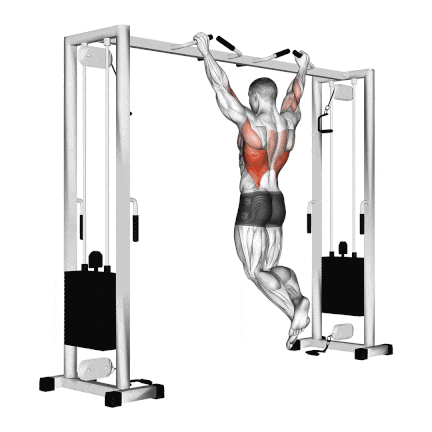
How To Do It Properly
- Use an overhand grip to grab a pull-up bar with your arms wide apart.
- Hang from the bar with your arms fully extended.
- Pull yourself up by contracting your lats and squeezing your shoulder blades together.
- Hold the contraction at the top briefly before slowly returning to the starting position.
8. Lat Pulldown
The Lat pulldown is popular for training the upper back muscles, particularly the latissimus dorsi. The exercise also engages other muscles, including the biceps, trapezius, and shoulders, to some extent.
The lat pulldown is an exercise used to build the back muscles. It is a great exercise for the back that is widely used by fitness trainers to build bigger lats. It specifically focuses on the back muscles without tiring out the biceps or triceps.
The lat pulldown can be performed with different variations. With simple adjustments to your grip, posture, or the type of bar you use, you can turn this classic exercise into a multi-faceted tool for back development.
- Wide-grip lat pulldown
- Close-grip lat pulldown
- Reverse-grip (supination) lat pulldown
- Neutral-grip lat pulldown
- Straight-arm lat pulldown
- Single-arm lat pulldown… Many More
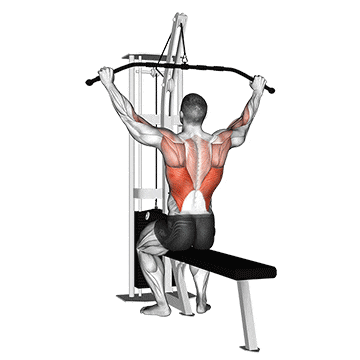
How To Do It Properly
- Take an overhand grip, hands slightly wider than shoulder-width apart, and sit on the machine seat.
- Keep your upper back straight, pull the bar down and bring it up to the chest.
- When you pull down, squeeze your shoulder blades together and feel your back muscles tighten.
- This movement should be performed using your upper lats, and the arms should merely serve as a lever between the bar and the lats.
- Now let go of the bar slowly and stretch your lats as much as you can.
9. Bent Over Barbell Rows
The bent-over row is a popular exercise for building back muscles and is considered one of the best exercises for building muscle.
Sometimes referred to as the barbell row, the bent-over row is a staple movement in most muscle-building workouts. Those looking to build muscle utilize the bent-over row to target their back, bicep, and core muscles. Powerlifters and strength groups do bent-over rows to strengthen the big three movements.
Try different grip positions.
- A narrow grip keeps the elbows close to the body, which makes it harder to extend the shoulders and pull them away from the body. This forces the lat muscles to work harder, which strengthens them.
- The wide grip encouraged by the flared elbows helps reduce lat involvement, allowing you to target the rhomboids, traps and rear delt.
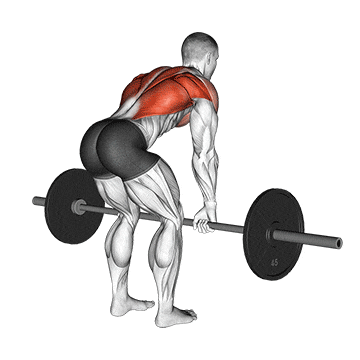
How To Do It Properly
- Take a narrow stance and grab a bar with an overhand grip.
- Bend your torso forward at an angle of 45 degrees to the floor with the knees slightly, and let the bar hang in front of you
- Hold a neutral spine throughout the movement to prevent injury.
- Lift the bar until it touches the abdominal region and not the chest region, as it reduces back muscle contraction.
- Slowly return the bar to the starting position under control.
10. Seated Cable Rows
Seated cable rows are an excellent exercise for building middle back muscles, which also works on lower lats.
In contrast to other free-weight variations, the classic seated row maintains constant tension throughout the movement.
The cable row training offers almost unmatched versatility because you can easily change the load, angle, grip, and body positioning.
- A pronated (overhand) grip tends to target the upper and middle trapezius,
- Whereas, a neutral (thumbs up) grip hits the middle and lower trapezius.
- A supinated (underhand) grip switches the focus to the latissimus dorsi.
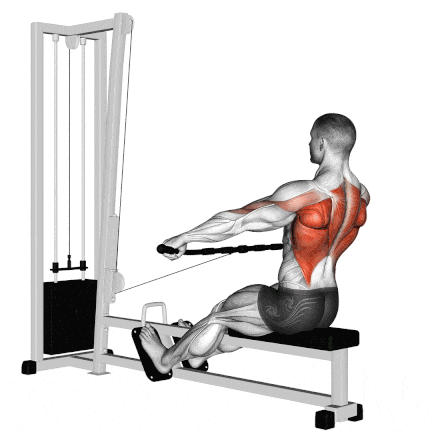
How To Do It Properly
- Sit on a seated cable pulley rowing machine with legs bent and feet supported against the crossbar.
- Grip the handles with your arms extended and your back stretched.
- Keep your knees slightly bent to avoid knee and lower back pressure.
- Pull the handles to come as close to the lower chest as possible.
- Pause briefly when the handles are close to the chest and squeeze your upper back muscles, bringing the scapulae closer.
- Slowly return the handle to the starting position.
11. T Bar Rows
T-bar Rows are a power exercise for building middle back muscles. Check the correct execution technique and blast your back muscles. When done with a narrower grip, they also work on the outer lats.
It is a tough exercise, but building a strong back is a must to develop a quality physique and stay injury-free and back pain-free for life.
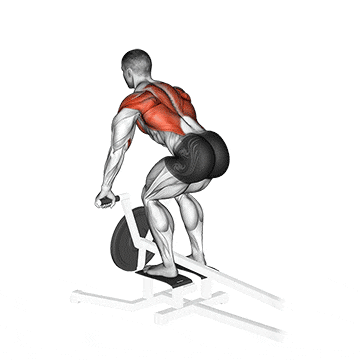
How To Do It Properly
- Standing on a T bar machine, grab its handles with an overhand grip.
- Keep your feet a bit apart and knees slightly bent.
- Bend at the hips and keep your back arched throughout the movement.
- Keep the back straight by lifting the bar until it touches your chest.
- Now slowly lower the bar until it nearly touches the ground.
12. Deadlift
The deadlift is the King of all exercises. This power exercise is designed to build an overall physique that utilizes more muscles than any other exercise. The deadlift is the best exercise for posterior chain muscle strengthening. It works on your whole body, including the lower back, upper back, arms, legs, and buttocks.
It is the biggest muscle builder, recruiting more muscle motor units than any other exercise. This exercise can be performed using either a barbell or a pair of dumbbells.
You can go real heavy on a barbell deadlift, but do this exercise with caution and technique.
Deadlift variations for back growth:
- Dumbbell Deadlift
- Cable Deadlift
- Barbell rack pull
- Romanian deadlift
- One Leg Dumbbell Romanian Deadlifts
- Landmine Deadlift
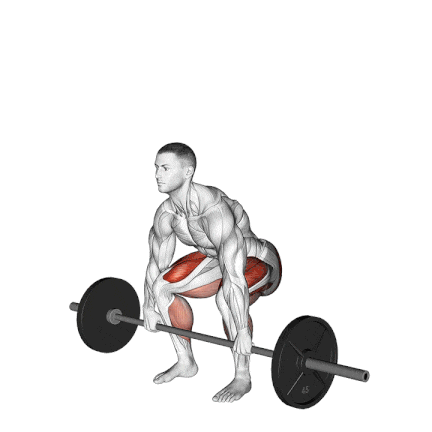
How To Do It
- Place a barbell loaded in front of you.
- Use an underhanded grip with one hand and an overhand grip with the other hand to grab the barbell.
- Remember to keep your back as straight as possible and contract your back and hamstrings.
- Now raise the bar from the ground using your hamstrings and glutes.
- You should keep your legs slightly bent, your back straight, and your head looking up. Your heels, not toes or elbows, should provide the initial movement.
- Raise it to the point where your body is erect. Do not hyperextend your body as the weight shifts to the lumbar spine.
- Hold the bar momentarily at the top of the lift.
- Now lower the bar slowly at a steady slow pace by bending at the hips first and then at the knees and let the weight touch the ground for a moment before you begin the next rep
- If you’re going heavy (sets of fewer than about 6 reps), do deadlifts first, so you’re fresh. If you’re doing for repetitions, you can do them later in your workout.
How To Design Chest Back Workout
To structure an effective chest back workout to increase mass and strength, the number of reps and sets, will vary based on your fitness level, weekly workout frequency, and strength training goals.
1. Weekly Sets For Each Muscle Group
According to the latest scientific evidence, 12–20 weekly sets per muscle group may optimize muscle growth.
- Beginners: ~10 sets per week.
- Intermediate: ~15 sets per week.
- Advanced: ~20 sets per week.
When a certain amount of volume stops being effective and your progress stalls, you can add sets to increase volume and use that as a driver of renewed progress.
Of course, the number of sets and reps will be determined based on your fitness journey, but here is a great starting point:
2. Select Reps Based On Your Goal
The best rep ranges and loads to work with.
- For strength gains, perform 4-6 reps with a weight that is at least 85% of your one-repetition maximum (1RM). The fewer reps you perform, the closer to 100% of your 1RM you should strive for.
- If your goal is hypertrophy (muscle growth), use loads that are 70 to 85% of your 1RM for 8 to 12 reps.
- When training for endurance, use higher reps (15 to 20 repetitions) and moderate loads, least 50 to 70% of your 1RM.
It is always best to start with a lower number of reps and sets, and then gradually increase as your strength improves
3. Design Your Chest Back Workout Routine Split
Finding the right place for the chest back workout in your training split can greatly enhance your weight training routine. Find out how this combination works well with different workout schedules.
4-Day Split
This is a two-day-per-week back and chest specialization workout that is designed to help you strengthen your upper body. Please find a sample schedule below.
- Monday—Back and Chest Workout #1
- Thursday—Back and Chest Workout #2
This type of program works best within the framework of a 4-day split.
- Monday – Back and Chest
- Tuesday – Shoulders and Arms
- Wednesday – Off
- Thursday – Back and Chest
- Friday – Legs
- Saturday – Off
- Sunday – Off
4. Customize Based On Your Schedule
Tailor your training split to accommodate your availability and preferences:
- Train four consecutive days, followed by a rest day
- Train two consecutive days, followed by a rest day
- Opt for Monday, Tuesday, Thursday, and Friday workouts, with weekends off
The integration possibilities are endless—let your imagination guide you:
- Experiment with different combinations and variations
- Personalize your training split to suit your goals and time constraints
5. Beginner-Friendly Chest Back Workout Routine
Below you will find an easy-to-understand workout routine for beginners. This workout program consists of the primary back movements and will help you out with getting a good base of muscle mass and strength.
| Exercise | Sets | Reps |
|---|---|---|
| Push-Ups | 4 | 8+12 |
| Dumbbell Bench Press | 4 | 8+12 |
| Pull-Up | 3 | 8-10 |
| Bent Over Barbell Rows | 3 | 8-10 |
6. Back And Chest Workout Routine For Intermediate
We’ve got some effective workouts routine for intermediate and advanced, which include the exercises, sets, reps, so you can keep making progress.
Before you get into your working sets, make sure to warm-up with at least two lighter sets, pyramiding up in weight from 30 to 50-60% of your one-rep max. Keep the working sets to no higher than 80-85% of your one-rep max.
Train to failure for each set and allow at least 3-4 days of rest in between workouts for the same muscle group.
| Exercise | Sets | Reps |
|---|---|---|
| Lat Pull Down | 4 | 8-10 |
| Bent Over Barbell Rows | 3 | 10-12 |
| Seated Cable Rows | 3 | 6-8 |
| Incline Bench Press | 4 | 8-10 |
| Barbell Chest Press | 3 | 10-12 |
Advanced back and chest workout routine
| Chest Workout | Sets | Reps |
|---|---|---|
| Barbell Bench Press | 4 | 6-8 |
| Incline Dumbbell Press | 3 | 8-10 |
| Dips | 3 | 8-10 |
| Cable Crossovers | 3 | 10-12 |
| Push-ups (Weighted if possible) | 3 | max reps |
| Back Workout | Sets | Reps |
|---|---|---|
| Deadlifts | 4 | 5-6 |
| Single-Arm Dumbbell Rows | 4 | 6-8 |
| Bent Over Barbell Rows | 3 | 8-10 |
| Face Pulls | 3 | 10-12 |
| Weighted Pull-ups | 3 | 12-15 |
Chest Back Superset Workout Plan
A superset is doing two different exercises without enough rest in between.
The workout includes supersets, which means you’ll do two exercises for the same muscle group back-to-back, then rest and repeat one or more times. You’ll use enough weight that you can only complete 8 to 12 repetitions per set.
Superset 1
- Push-Ups: 4 sets of 8-12 reps (Immediately followed by)
- Pull-Up: 4 sets of 6-8 reps.
Superset 2
- Bent Over Barbell Rows: 3 sets of 10-12 reps, superset with,
- Barbell chest press: 3 sets of 8-10 reps.
Superset 3
- Decline Dumbbell Press: 3 sets of 8-10 reps, superset with,
- Lat Pull Down: 3 sets of 8-10 reps.
Superset 4
- Dumbbell Bench Press: 3 sets of 8-10 reps
- Dumbbell Row: 3 sets of 8-10 reps
Superset 5
- Decline Push-ups: 3 sets to failure
- Bent-Over Dumbbell Rear Delt Flyes: 3 sets of 10-12 reps
Note: Rest for 60-90 seconds between supersets. Adjust weights according to your fitness level and ensure proper form for each exercise.
FAQs
Can you train back and chest together?
Yes, you can train back and chest together in your workout regime. It’s actually preferred by many fitness gurus and bodybuilders to train them together.
How Many Sets and Reps Should I Do?
For just about every exercise of the back or chest, 3–4 work sets (the real work you do, not warm-up sets) is a good choice. But rep ranges fluctuate. You can go as low as 5 reps on heavy presses, and up to 15–30 reps for accessory work.
Back and Chest and superset workout
- Push-Ups Superset with Wide-Grip Pull-Up
- Push-ups Superset with Lat Pull Down
- Decline bench press Superset with Bent Over Barbell Rows
- Incline Bench press Superset with Seated Cable Rows
- Seated Machine Fly Superset with T Bar Rows
- Cable Crossover Superset with V-Grip Lat Pull Down
How Often You Are Able To Train
If you are able to train more often, you may choose to train back and chest more than twice a week, otherwise for most people, twice a week is enough to develop those groups maximally.
Should I train chest first or back first
If your relative weakness is your back muscles, you may choose to perform your back exercises first. If your relative weakness is your chest, you may choose to perform your chest exercises first.
Why You Should Train Back and Chest together on same day workout session
There can be many reasons why you would want to program your training in a certain order. People who train for muscle mass will often keep a single muscle group for each training day.
You can train back and chest in the same day workout session. There are many ways to program a training session safely and easily.
It can also make your workouts more efficient. However, you must consider your weaknesses to determine how you should structure your back and chest exercises.
Training back and chest on the same day can be effective, but how you do it depends on your goal. You may still train back and chest together, but you’ll want to organize the workout slightly differently depending on whether you are training for muscle mass or training for maximal strength.
Takeaways
Super setting back and chest exercises are not necessarily what you need to do when you come to train back and chest together, but it does make training two separate body parts more efficient.
You can perform the exercises as a traditional set i.e. each exercise at a time, but you may risk having very long training sessions.
The same principles can be applied to the other muscle groups as well. For example, when training back and legs together.
The Best Superset is that you can simply and effectively implement it in your workout. Try This Workout Superset.
I hope you liked our Back and chest workout.
References
- J Hum Kinet. 2022 Feb 10;81:199-210. A Systematic Review of The Effects of Different Resistance Training Volumes on Muscle Hypertrophy.
- Schoenfeld, B. J., Ogborn, D., & Krieger, J. W. (2016). Effects of Resistance Training Frequency on Measures of Muscle Hypertrophy: A Systematic Review and Meta-Analysis. Sports medicine (Auckland, N.Z.), 46(11), 1689–1697.
- Hackett D.A., Johnson N.A., Chow C.M. Training Practices and Ergogenic Aids Used by Male Bodybuilders. J. Strength Cond. Res. 2013;27:1609–1617. doi: 10.1519/JSC.0b013e318271272a.
- Eur J Sport Sci. 2017 Sep;17(8):983-993. The effects of short versus long inter-set rest intervals in resistance training on measures of muscle hypertrophy: A systematic review.
- Int. J. Environ. Res. Public Health 2020, 17(19), 7339. Effect of Five Bench Inclinations on the Electromyographic Activity of the Pectoralis Major, Anterior Deltoid, and Triceps Brachii during the Bench Press Exercise.

Manish is a NASM-certified fitness and nutrition coach with over 10 years of experience in weight lifting and fat loss fitness coaching. He specializes in gym-based training and has a lot of knowledge about exercise, lifting technique, biomechanics, and more.
Through “Fit Life Regime,” he generously shares the insights he’s gained over a decade in the field. His goal is to equip others with the knowledge to start their own fitness journey.
